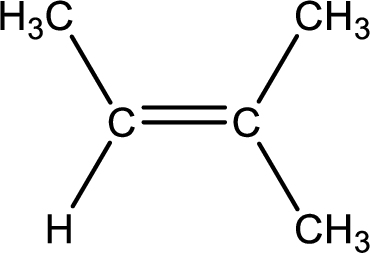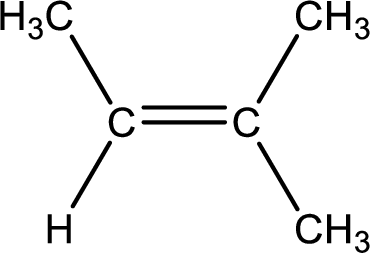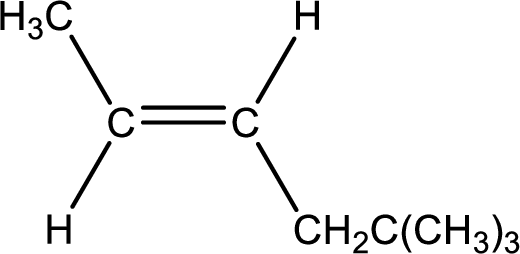
GENERAL,ORGANIC,+BIOCHEMISTRY(LL)-PKG
10th Edition
ISBN: 9781260699227
Author: Denniston
Publisher: MCGRAW-HILL HIGHER EDUCATION
expand_more
expand_more
format_list_bulleted
Question
Chapter 11.3, Problem 11.8Q
(a)
Interpretation Introduction
Interpretation:
Given compound has to be named according to

Concept Introduction:
A common nomenclature of naming organic compounds has been developed by IUPAC. By usage of this nomenclature or rules, memorizing of names of organic compounds is not necessary.
IUPAC rules for naming
There are about five rules that has to be followed for naming an alkene and an
- The longest continuous carbon chain in the compound that contains double bond or triple has to be identified. This is known as parent compound.
- Suffix “–ane” (in name of
alkane ) is replaced with “-ene” for alkene or “-yne” for alkyne. - Numbering has to be done so that the lowest number is given to the double or triple bond.
- Naming and numbering has to be given for each atom or group that is attached to the parent chain. Numbering has to be done in a way that substituents get the least numbering.
- If the alkenes have more than one double bond they are called as alkadienes (two double bonds) or alkatrienes (three double bonds). Appropriate suffix has to be used depending on the number of multiple bonds present in the compound.
- Stereoinformation has to be included in the IUPAC name in the starting. This can be either cis- or trans- for alkene.
(b)
Interpretation Introduction
Interpretation:
Given compound has to be named according to IUPAC nomenclature.

Concept Introduction:
Refer part (a).
(c)
Interpretation Introduction
Interpretation:
Given compound has to be named according to IUPAC nomenclature.

Concept Introduction:
Refer part (a).
Expert Solution & Answer
Want to see the full answer?
Check out a sample textbook solution
Students have asked these similar questions
3. Synthesize the following synthon from the indicated
starting material.
i
HO.
Identifying the stereochemistry of natural
Write the complete common (not IUPAC) name of each molecule below.
Note: if a molecule is one of a pair of enantiomers, be sure you start its name with D- or L- so we know which enantiomer it is.
molecule
H
O-C-CH2
H3N.
HN
N
H
C=O
common name
(not the IUPAC
name)
NH3
☐
H3N
H
☐
CH2
X
>
Draw the structure of alanine at pH 1.2.
Click and drag to start drawing a
structure.
Chapter 11 Solutions
GENERAL,ORGANIC,+BIOCHEMISTRY(LL)-PKG
Ch. 11.2 - Name each of the following alkenes and alkynes...Ch. 11.2 - Prob. 11.2PPCh. 11.2 - Prob. 11.1QCh. 11.2 - Prob. 11.2QCh. 11.3 - Prob. 11.3PPCh. 11.3 - Prob. 11.4PPCh. 11.3 - Prob. 11.5PPCh. 11.3 - Prob. 11.3QCh. 11.3 - Prob. 11.4QCh. 11.3 - Prob. 11.5Q
Ch. 11.3 - Draw each of the cis-trans isomers in Question...Ch. 11.3 - Prob. 11.7QCh. 11.3 - Prob. 11.8QCh. 11.5 - Prob. 11.6PPCh. 11.5 - Prob. 11.7PPCh. 11.5 - Prob. 11.9QCh. 11.5 - Write balanced equations for the hydrogenation of...Ch. 11.5 - Prob. 11.11QCh. 11.5 - Prob. 11.12QCh. 11.5 - Prob. 11.8PPCh. 11.5 - Prob. 11.13QCh. 11.5 - Prob. 11.14QCh. 11.5 - Prob. 11.15QCh. 11.5 - Prob. 11.16QCh. 11.5 - Prob. 11.9PPCh. 11.5 - Prob. 11.17QCh. 11.5 - Prob. 11.18QCh. 11.5 - Prob. 11.19QCh. 11.5 - Prob. 11.20QCh. 11.5 - Write a balanced equation for the hydrobromination...Ch. 11.6 - Name the following compounds using the IUPAC and...Ch. 11.6 - Prob. 11.21QCh. 11.6 - Prob. 11.22QCh. 11 - Prob. 11.23QPCh. 11 - Prob. 11.24QPCh. 11 - Prob. 11.25QPCh. 11 - Prob. 11.26QPCh. 11 - Prob. 11.27QPCh. 11 - Prob. 11.28QPCh. 11 - Prob. 11.29QPCh. 11 - Prob. 11.30QPCh. 11 - Prob. 11.31QPCh. 11 - Prob. 11.32QPCh. 11 - Prob. 11.33QPCh. 11 - Prob. 11.34QPCh. 11 - Prob. 11.35QPCh. 11 - Prob. 11.36QPCh. 11 - Prob. 11.37QPCh. 11 - Prob. 11.38QPCh. 11 - Prob. 11.39QPCh. 11 - Prob. 11.40QPCh. 11 - Prob. 11.41QPCh. 11 - Prob. 11.42QPCh. 11 - Prob. 11.43QPCh. 11 - Prob. 11.44QPCh. 11 - Prob. 11.45QPCh. 11 - Prob. 11.46QPCh. 11 - Which of the following alkenes can exist as...Ch. 11 - Prob. 11.48QPCh. 11 - Prob. 11.49QPCh. 11 - Prob. 11.50QPCh. 11 - Prob. 11.51QPCh. 11 - Prob. 11.52QPCh. 11 - Prob. 11.53QPCh. 11 - Prob. 11.54QPCh. 11 - Prob. 11.55QPCh. 11 - Prob. 11.56QPCh. 11 - Prob. 11.57QPCh. 11 - Prob. 11.58QPCh. 11 - Prob. 11.59QPCh. 11 - Prob. 11.60QPCh. 11 - Prob. 11.61QPCh. 11 - Prob. 11.62QPCh. 11 - Prob. 11.63QPCh. 11 - Prob. 11.64QPCh. 11 - Prob. 11.65QPCh. 11 - Prob. 11.66QPCh. 11 - Prob. 11.67QPCh. 11 - Prob. 11.68QPCh. 11 - Prob. 11.69QPCh. 11 - Prob. 11.70QPCh. 11 - Prob. 11.71QPCh. 11 - Prob. 11.72QPCh. 11 - Prob. 11.73QPCh. 11 - Prob. 11.74QPCh. 11 - Prob. 11.75QPCh. 11 - Prob. 11.76QPCh. 11 - Prob. 11.77QPCh. 11 - Prob. 11.78QPCh. 11 - Prob. 11.79QPCh. 11 - Prob. 11.80QPCh. 11 - Prob. 11.81QPCh. 11 - Prob. 11.82QPCh. 11 - Prob. 11.83QPCh. 11 - Write an equation for the addition reaction that...Ch. 11 - Prob. 11.85QPCh. 11 - Draw the structure of each of the following...Ch. 11 - Prob. 11.87QPCh. 11 - Prob. 11.88QPCh. 11 - Prob. 11.89QPCh. 11 - Prob. 11.90QPCh. 11 - Prob. 11.91QPCh. 11 - Prob. 11.92QPCh. 11 - Draw each of the following compounds, using...Ch. 11 - Prob. 11.94QPCh. 11 - Prob. 11.95QPCh. 11 - Prob. 11.96QPCh. 11 - Prob. 11.97QPCh. 11 - Prob. 11.98QPCh. 11 - Prob. 11.99QPCh. 11 - Prob. 11.100QPCh. 11 - Prob. 11.101QPCh. 11 - Prob. 11.102QPCh. 11 - Prob. 11.103QPCh. 11 - What biological molecules contain purine rings?
Ch. 11 - Prob. 1MCPCh. 11 - Prob. 3MCPCh. 11 - Prob. 5MCPCh. 11 - Prob. 6MCPCh. 11 - Prob. 7MCPCh. 11 - Prob. 8MCPCh. 11 - Prob. 9MCPCh. 11 - Prob. 10MCP
Knowledge Booster
Learn more about
Need a deep-dive on the concept behind this application? Look no further. Learn more about this topic, chemistry and related others by exploring similar questions and additional content below.Similar questions
- Understanding the general acid-base properties of amino acids O Proteins Imagine each of the molecules shown below was found in an aqueous solution. Can you tell whether the solution is acidic, basic, or neutral? molecule The solution is... 010 H3N-CH-C-OH CH HO CH3 O acidic O basic neutral O (unknown) H3N HO 0 O acidic O basic neutral ○ (unknown) H3N-CH-C-O CH2 CH3-CH-CH3 O acidic O basic Oneutral ○ (unknown) O= X H2N-CH-C-O CH3 CH CH3 acidic O basic O neutral ○ (unknown) ? 000arrow_forwardImagine each of the molecules shown below was found in an aqueous solution. Can you tell whether the solution is acidic, basic, or neutral? molecule 0=0 H3N-CH-C-o HO CH2 OH The solution is... O acidic O basic O neutral O (unknown) H₂N acidic O basic O neutral ○ (unknown) + H3N O OH O acidic O basic O neutral O (unknown) H2N-CH-C-O CH3 O acidic O basic neutral ○ (unknown) X ? olo HEarrow_forwardRecognizing ampli Draw an a amino acid with a methyl (-CH3) side chain. Explanation Check Click and drag to start drawing a structure. X Carrow_forward
- Write the systematic name of each organic molecule: structure name × HO OH ☐ OH CI CI O CI OH OHarrow_forwardく Check the box under each a amino acid. If there are no a amino acids at all, check the "none of them" box under the table. Note for advanced students: don't assume every amino acid shown must be found in nature. COO H3N-C-H CH2 HO CH3 NH3 O CH3-CH CH2 OH Onone of them Explanation Check + H3N O 0. O OH + NH3 CH2 CH3-CH H2N C-COOH H O HIC + C=O H3N-C-O CH3- - CH CH2 OH Х 2025 McGraw Hill LLC. All Rights Reserved. Terms of Use | Privacy Center Accesarrow_forwardWrite the systematic name of each organic molecule: structure HO-C-CH2-CH3 O -OH CH3-CH2-CH2-CH2-CH2-C-OH CH3 CH3-CH-CH2-C-OH Explanation Check S namearrow_forward
- theres 2 productsarrow_forwardDraw the major product of this solvolysis reaction. Ignore any inorganic byproducts. + CH3CH2OH Drawing Q Atoms, Bonds and Rings OCH2CH3 || OEt Charges OH 00-> | Undo Reset | Br Remove Done Drag To Pan +arrow_forwardDraw the major product of this SN1 reaction. Ignore any inorganic byproducts. CH3CO2Na CH3CO2H Drawing + Br Q Atoms, Bonds and Rings OAC Charges OH ОАс Na ဂ Br Undo Reset Remove Done Drag To Pan +arrow_forward
- Organic Functional Groups entifying positions labeled with Greek letters in acids and derivatives 1/5 ssible, replace an H atom on the a carbon of the molecule in the drawing area with a ce an H atom on the ẞ carbon with a hydroxyl group substituent. ne of the substituents can't be added for any reason, just don't add it. If neither substi er the drawing area. O H OH Oneither substituent can be added. Check D 1 Accessibility ado na witharrow_forwardDifferentiate between electrophilic and nucleophilic groups. Give examples.arrow_forwardAn aldehyde/ketone plus an alcohol gives a hemiacetal, and an excess of alcohol gives an acetal. The reaction is an equilibrium; in aldehydes, it's shifted to the right and in ketones, to the left. Explain.arrow_forward
arrow_back_ios
SEE MORE QUESTIONS
arrow_forward_ios
Recommended textbooks for you
 ChemistryChemistryISBN:9781305957404Author:Steven S. Zumdahl, Susan A. Zumdahl, Donald J. DeCostePublisher:Cengage Learning
ChemistryChemistryISBN:9781305957404Author:Steven S. Zumdahl, Susan A. Zumdahl, Donald J. DeCostePublisher:Cengage Learning ChemistryChemistryISBN:9781259911156Author:Raymond Chang Dr., Jason Overby ProfessorPublisher:McGraw-Hill Education
ChemistryChemistryISBN:9781259911156Author:Raymond Chang Dr., Jason Overby ProfessorPublisher:McGraw-Hill Education Principles of Instrumental AnalysisChemistryISBN:9781305577213Author:Douglas A. Skoog, F. James Holler, Stanley R. CrouchPublisher:Cengage Learning
Principles of Instrumental AnalysisChemistryISBN:9781305577213Author:Douglas A. Skoog, F. James Holler, Stanley R. CrouchPublisher:Cengage Learning Organic ChemistryChemistryISBN:9780078021558Author:Janice Gorzynski Smith Dr.Publisher:McGraw-Hill Education
Organic ChemistryChemistryISBN:9780078021558Author:Janice Gorzynski Smith Dr.Publisher:McGraw-Hill Education Chemistry: Principles and ReactionsChemistryISBN:9781305079373Author:William L. Masterton, Cecile N. HurleyPublisher:Cengage Learning
Chemistry: Principles and ReactionsChemistryISBN:9781305079373Author:William L. Masterton, Cecile N. HurleyPublisher:Cengage Learning Elementary Principles of Chemical Processes, Bind...ChemistryISBN:9781118431221Author:Richard M. Felder, Ronald W. Rousseau, Lisa G. BullardPublisher:WILEY
Elementary Principles of Chemical Processes, Bind...ChemistryISBN:9781118431221Author:Richard M. Felder, Ronald W. Rousseau, Lisa G. BullardPublisher:WILEY

Chemistry
Chemistry
ISBN:9781305957404
Author:Steven S. Zumdahl, Susan A. Zumdahl, Donald J. DeCoste
Publisher:Cengage Learning

Chemistry
Chemistry
ISBN:9781259911156
Author:Raymond Chang Dr., Jason Overby Professor
Publisher:McGraw-Hill Education

Principles of Instrumental Analysis
Chemistry
ISBN:9781305577213
Author:Douglas A. Skoog, F. James Holler, Stanley R. Crouch
Publisher:Cengage Learning

Organic Chemistry
Chemistry
ISBN:9780078021558
Author:Janice Gorzynski Smith Dr.
Publisher:McGraw-Hill Education

Chemistry: Principles and Reactions
Chemistry
ISBN:9781305079373
Author:William L. Masterton, Cecile N. Hurley
Publisher:Cengage Learning

Elementary Principles of Chemical Processes, Bind...
Chemistry
ISBN:9781118431221
Author:Richard M. Felder, Ronald W. Rousseau, Lisa G. Bullard
Publisher:WILEY
07 Physical Properties of Organic Compounds; Author: Mindset;https://www.youtube.com/watch?v=UjlSgwq4w6U;License: Standard YouTube License, CC-BY